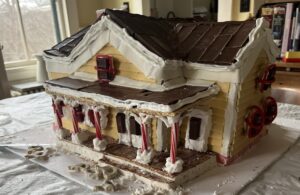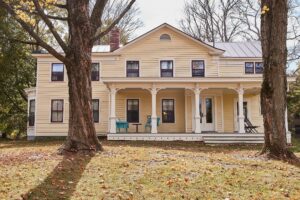In December 2023, I took on what was in some ways my most challenging Worth Preserving project to date. Challenging because, all at once, I played architect, engineer, construction manager, builder and client. And because the materials and technology were rather new to me. In short, I built a gingerbread house.
Inspired by a townwide holiday celebration, the opportunity to raise money for local families, and a “bucket list” notion to recreate an early Worth Preserving project in candy-coated miniature, I summoned all my decades of practical building and Great British Baking Show knowledge to the task.
Fortunately, unlike most of my projects that take months if not years to complete, this job consumed a weekend only. Oh, but what a weekend!
Something about the meticulous tedium of gingerbread construction – sort of like painting – got my mind running about the care and stewardship of real houses. Here are some observations:
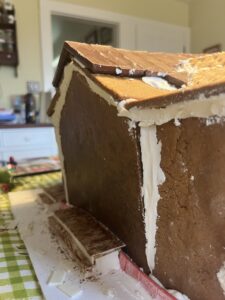
1. Foundations are everything. Gingerbread houses don’t have basements or footings (at least mine didn’t!). They sit squarely on the flat surface of some kind of base (mine was foamcore), supported only by the innate strength of the walls (fully baked and rigid, one hopes) and gobs of royal icing that hardens like cement. Some leaning and buckling is to be expected as everything sets up. Real 100- or 200-year-old houses do this, too. One often finds sloped floors and sagging roof lines that may have occurred within the first few years after construction and usually aren’t of major concern. But if the foundation continues to move, the whole structure is at risk.
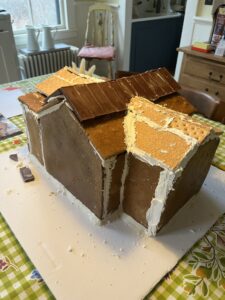
2. Framing is important, too. As alluded to above, real houses shape shift. Framing is essentially trees turned into lumber, continuing to expand and contract with temperature, moisture, etc. Too light framing can bow under the weight of other construction materials or snow load. I made the roof of my gingerbread house out of two rectangular cookies, 11 inches long – this span proved too great, and the rectangles sagged from the get-go. I set up some interior candy-cane columns and reinforced the roof structure with chocolate sheathing. Good thing it doesn’t snow in gingerbread world!
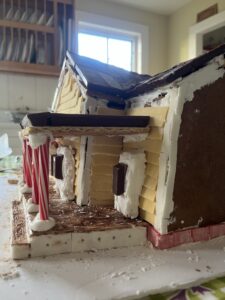
3. Water kills buildings. A line from “This Old House”… Again, I’m lucky that gingerbread houses are perpetually dry or there would be some real problems. My porches all pitched backwards towards the foundation, which in real life would result in a wet basement, at the very least. Eventually the sills (the thick wood beam that runs around the perimeter of a house on top of the foundation and serves as the framing base), sheathing and clapboard would rot. Then you get insects, mold and other critters moving in – to them, a real house is much yummier and more hospitable than a candy one.
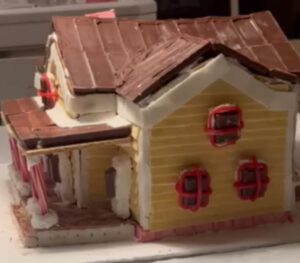 4. Windows – they just don’t make them like they used to. Original double-hung, single-glazed windows made of old-growth wood have a special place in my heart. In my gingerbread world, windows are made of thick chocolate bars, Twizzlers and royal-icing caulk. In my opinion, these are still preferable to shoddy vinyl windows! Even high-end modern windows have a finite lifespan before they head for the landfill, whereas old windows can be repeatedly repaired (as can my Twizzler windows, in theory…).
4. Windows – they just don’t make them like they used to. Original double-hung, single-glazed windows made of old-growth wood have a special place in my heart. In my gingerbread world, windows are made of thick chocolate bars, Twizzlers and royal-icing caulk. In my opinion, these are still preferable to shoddy vinyl windows! Even high-end modern windows have a finite lifespan before they head for the landfill, whereas old windows can be repeatedly repaired (as can my Twizzler windows, in theory…).
I could keep going about flashing, chimney pointing, and on and on. One big-picture reflection – my gingerbread house has an immediate, useful purpose and looks good on the surface (with eyes squinted), but it wasn’t built to last. Real-world historic rehabilitation and home stewardship take a much, much longer view. They rely on a clear understanding of how buildings work, how materials and technologies (old and new) perform, and what expertise is needed to address issues that inevitably arise over time.
The moment will be bittersweet when I finally toss my gingerbread house into the trash post-holidays. At the same time, its demise will strengthen my resolve to preserve the places that really matter, not just at Christmas, but for generations to come.
